Britons who spoke of their pasts in India remembered the need for
diversions from what they saw as everyday lives of hard work and
often difficult conditions. Indeed these diversions--especially
the abundance of field sports--were seen as among the joys
of a life in India.
An Englishman in India could maintain horses whose upkeep in England
would have been prohibitively expensive. Thus he could have plenty of
recreational or competitive horseback riding. And the plenitude of
wild game provided the shooting beloved by the English upper classes, but
in India people could enjoy it without the need for private estates
or trout streams.
In the hot season, when an intense sun baked the Indian plains, "the
Hills" offered another kind of diversion, the relief of cool weather
at high altitudes. From the early 19th century the British developed
"hill stations," towns they could go up to when heat enveloped the
rest of India. In fact, whole governments moved to the Hills in the
hot months. Simla in the Himalayas became the official summer capital
of British India when the Viceroy and much of the bureaucracy came up
from Calcutta or New Delhi. With temporarily concentrated European
populations, the hill stations were noted for gay, leisurely life,
though working husbands customarily came for only short periods
while their wives might spend the whole season.
Closer to home, the club offered a respite from daily routine.
Virtually wherever in India a few Britons lived, a club evolved.
It might have only a modest bar, a tennis court, perhaps a reading room,
but it was an important institution as a central gathering place. The
admission or exclusion of Indians as members or guests became a
difficult issue in Indo-British relations as time went on.
 Paying off the beaters after a tiger hunt; 20th century; photograph
courtesy of the Centre of South Asian Studies, University of Cambridge.
Paying off the beaters after a tiger hunt; 20th century; photograph
courtesy of the Centre of South Asian Studies, University of Cambridge.
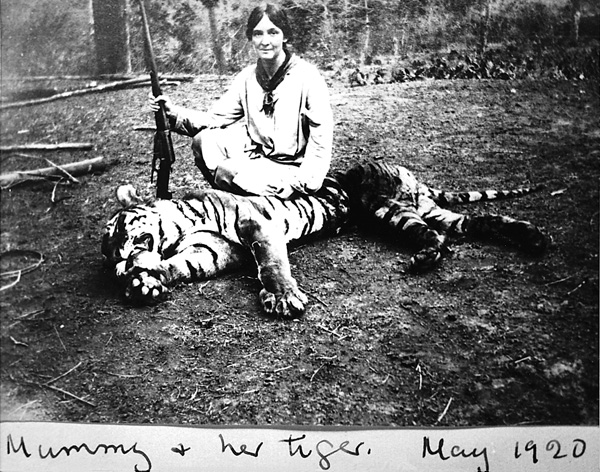 Joining in field sports enabled English women to participate more fully
in the pleasures of life in India; photograph courtesy of Major General
R.C.A. Edge.
Joining in field sports enabled English women to participate more fully
in the pleasures of life in India; photograph courtesy of Major General
R.C.A. Edge.
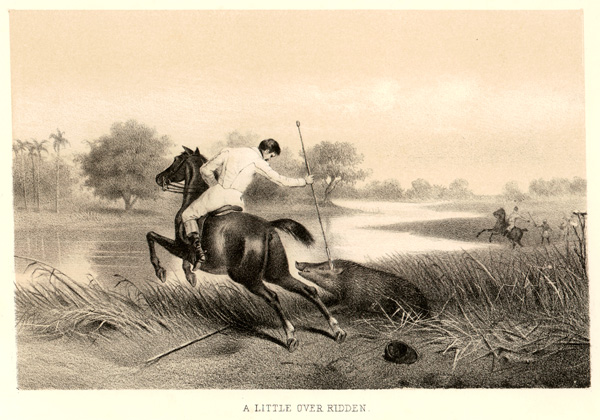 "A Little Over Ridden"; lithograph; 19th century.
Hog hunter, probably along the Ganges River.
The sport of hog hunting (or "pig sticking") involved chasing on
horseback and spearing dangerous wild hogs. Though limited geographically,
the sport had a very popular image, perhaps because it seemed to evoke
ancient ways and almost feudal methods of organization.
"A Little Over Ridden"; lithograph; 19th century.
Hog hunter, probably along the Ganges River.
The sport of hog hunting (or "pig sticking") involved chasing on
horseback and spearing dangerous wild hogs. Though limited geographically,
the sport had a very popular image, perhaps because it seemed to evoke
ancient ways and almost feudal methods of organization.
 "The Return from Hog Hunting"; aquatint by Samuel Hewett from a
drawing by Captain Thomas Williamson; 1819.
"The Return from Hog Hunting"; aquatint by Samuel Hewett from a
drawing by Captain Thomas Williamson; 1819.
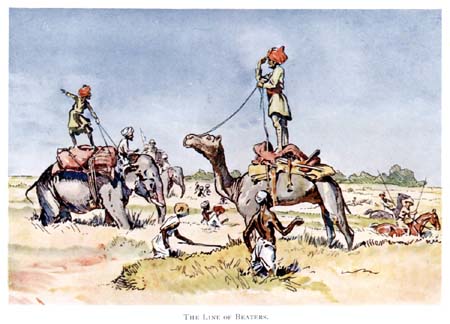 "The Line of Beaters," color illustration (from a water color by the author)
in Pig-Sticking or Hog-Hunting: A Complete Account for Sportsmen--and
Others by Sir Robert Baden-Powell, Bart. (London: Herbert Jenkins, 1924).
"The Line of Beaters," color illustration (from a water color by the author)
in Pig-Sticking or Hog-Hunting: A Complete Account for Sportsmen--and
Others by Sir Robert Baden-Powell, Bart. (London: Herbert Jenkins, 1924).
The founder of the Boy Scouts, who had seen Army service in India,
was a notable devotee of the sport.
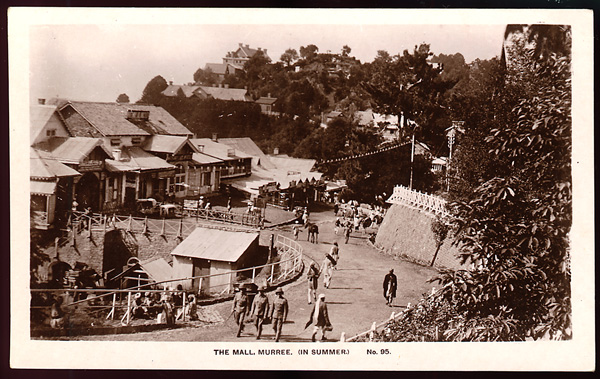 British soldiers on the Mall at Murree, a popular hill station; postcard; 1920s.
British soldiers on the Mall at Murree, a popular hill station; postcard; 1920s.
 "Simla--the Mall"; postcard, photograph by R. Hotz; c. 1900. Simla, where the Government of India functioned during the hot
weather, was a vibrant temporary capital. The architecture seen here is
notably European, as though the Hills were meant to be psychologically
as well as physically removed from the terrible heat and
related pressures of the Indian plains.
"Simla--the Mall"; postcard, photograph by R. Hotz; c. 1900. Simla, where the Government of India functioned during the hot
weather, was a vibrant temporary capital. The architecture seen here is
notably European, as though the Hills were meant to be psychologically
as well as physically removed from the terrible heat and
related pressures of the Indian plains.

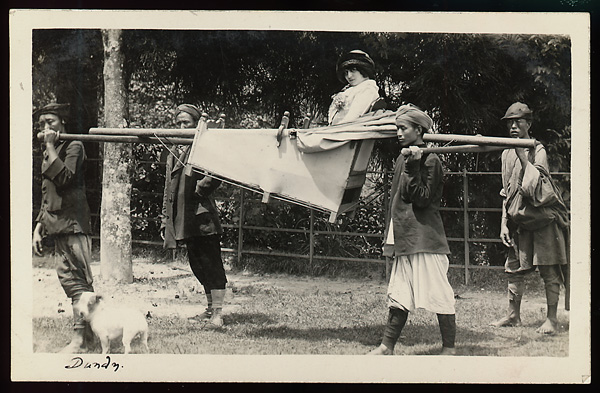 Women in dandi, sedan chairs used to carry European travellers
through the Hills; postcards (Umballa: Herman Dass and Sons); 1890s.
Women in dandi, sedan chairs used to carry European travellers
through the Hills; postcards (Umballa: Herman Dass and Sons); 1890s.
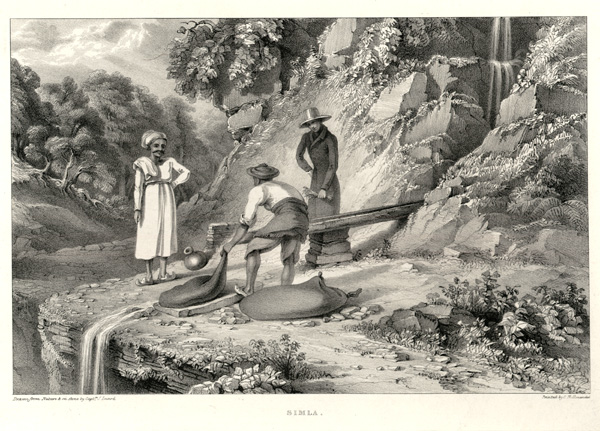
"Simla"; lithograph by Captain J. Luard; 19th century. Only the workers in Indian garb suggest that this is not a European landscape, as though the Hills were not merely a refuge from the heat but a kind of symbolic return to a more culturally familiar place.
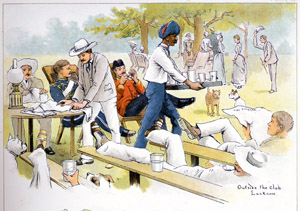 Club scene; color illustrations in Lloyd's
Sketches of Indian Life by W. Lloyd (London: Chapman and Hall, 1890).
Club scene; color illustrations in Lloyd's
Sketches of Indian Life by W. Lloyd (London: Chapman and Hall, 1890).

 Two clubs: British Indian clubs might be as grand as the "Royal
Bombay Yacht Club" or as simple as that in a smaller station,
such as "Tennis Court & the Club, Nathiagali"; postcards;
early 20th century. On the reverse of the Bombay Yacht card a correspodent has
written:
"A lovely club. People have tea parties on the lawn (behind the wall)."
Two clubs: British Indian clubs might be as grand as the "Royal
Bombay Yacht Club" or as simple as that in a smaller station,
such as "Tennis Court & the Club, Nathiagali"; postcards;
early 20th century. On the reverse of the Bombay Yacht card a correspodent has
written:
"A lovely club. People have tea parties on the lawn (behind the wall)."
An Introduction
Acknowledgements
1. The Passage to India | interviews
2. Running Your Empire |
interviews
3. Life in the Bungalows |
interviews
4. Imperial Diversions |
interviews
5. Never the Twain? |
interviews
6. No More India to Go to |
interviews












